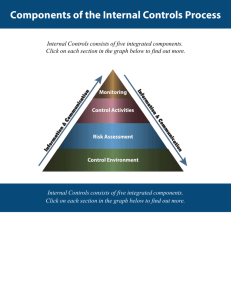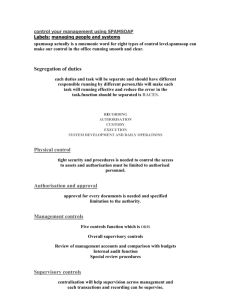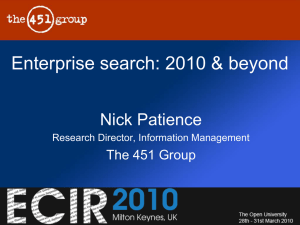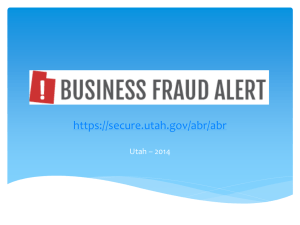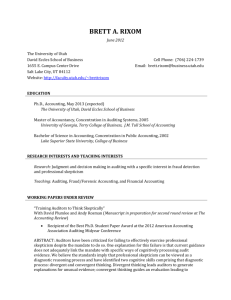Internal Controls and Risk Assessment
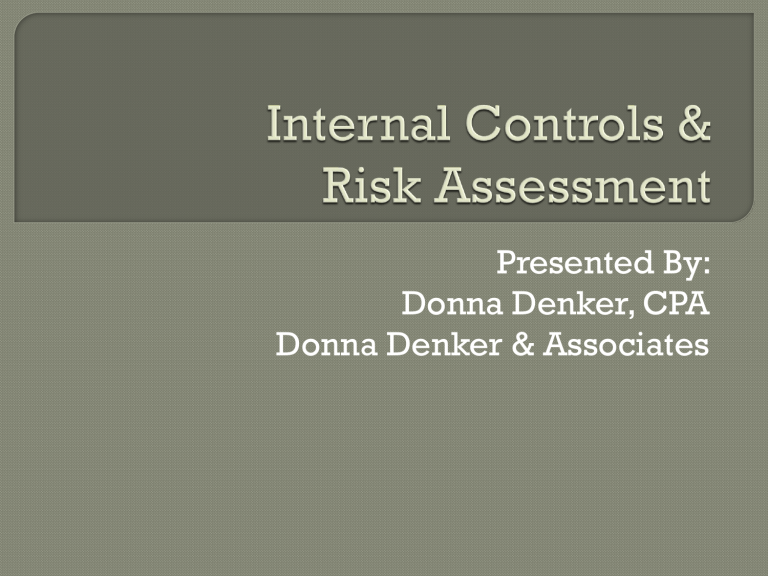
Presented By:
Donna Denker, CPA
Donna Denker & Associates
Per SAS 99 – (2002) – “An intentional act that results in material misstatement to the financial statements that are subject to an audit.”
Financial Reporting Fraud
Misappropriation of Assets
External Fraud
Diverting cash receipts
Lapping
Stealing or forging checks
Altering bank deposits
Stealing petty cash
Creating fictitious vendors or overstating vendor accounts
Stealing inventory or equipment
Taking kickbacks
Abusing travel and entertainment reimbursements
Creating ghost employees or overstating hours worked
Opportunity
Fraudster’s
Need
Rationalization
Defines internal controls
Describes the components of effective internal controls
Provides evaluation criteria for internal controls
Guidance on management’s reporting of internal controls over financial reporting
A process, effected by an entity’s board of directors, management and other personnel, designed to provide reasonable assurance regarding the achievement of objections in any of the following categories:
Efficiency and effectiveness of operations
Reliability of financial reporting
Compliance with applicable laws and regulations
Integrity
Ethical Values
Competency
Entity must be aware of and deal with risks it faces
Entity must set objectives integrated with other activities so that the organization works together
Entity must establish mechanisms to identify, analyze and manage the related risk
Establishment of policies to ensure that risks are addressed
Execution of policies to ensure they are carried out correctly and completely
Systems to capture and exchange information
Monitoring all of the processes
Allow modifications as necessary
System should react dynamically by changing as conditions warrant
Existence or Occurrence
Completeness
Rights and Obligations
Valuation and Allocation
Presentation and Disclosure
Establish organization control environment
Risk identification and analysis
Communications
Monitoring
Human judgment
Breakdowns
Management overrides
Collusion
Message from the board and management
Ethics policy and repercussions for violations
Conflict of Interest policies
Recognizing temptations
Hiring policies
In-house or external training
Outside consultants to supplement if needed
Performance and skills evaluated periodically
Board does performance and skills evaluations for management
Understand your fraud risks
Set the tone at the top – zero tolerance policy
Oversee internal controls
Retain outside experts when in doubt
Ask questions and exercise skepticism
Whistleblower program
Commitment to excellence
All journal entries are authorized, supported and reviewed
Organizational chart
Job descriptions
Roles are supportive of financial reporting objectives
Considerations of segregation of responsibility
Responsibilities are commiserate with authority
Empowers employees
HR policies
Job descriptions
Pre-employment investigation
Ensure appropriate training
Regular performance evaluations
Competency is considered
Exit interview with staff
Funding agents and regulatory bodies
Vendors
Tribal Council
Creditors
Access to assets
News media
Changes
Employees
Technology
Personnel practices
Access to assets
Changes
Previously identified failures
Complexity of activities
Brainstorming sessions
Regular management meetings to discuss issues
Reacting to changes in a timely manner
Education or training programs
Supervision
Personnel evaluations
Segregation of duties
Early identification of changes
Physical Controls
Segregation of Duties
IT Controls
Management activities
Budget monitoring
Policy and procedures
•
• Policies establish what should be done
Procedures establish how it should be done
Staff to Staff
Management to Staff
Upward communication to Board
Vendors
Funding Agents
Independent Auditors
Policies and procedures
Management meetings
Departmental meetings
Financial Statements and Budget Reports
External financial reporting
Reports from External Auditors or
Regulators
Supervision of staff performance
Budget to Actual expenditure comparisons
Reconciliations and comparisons to physical assets
Enforcement of policies
Bank and investment statements
Vendors monthly statements
Federal agencies communicating concerns
External or internal auditors
